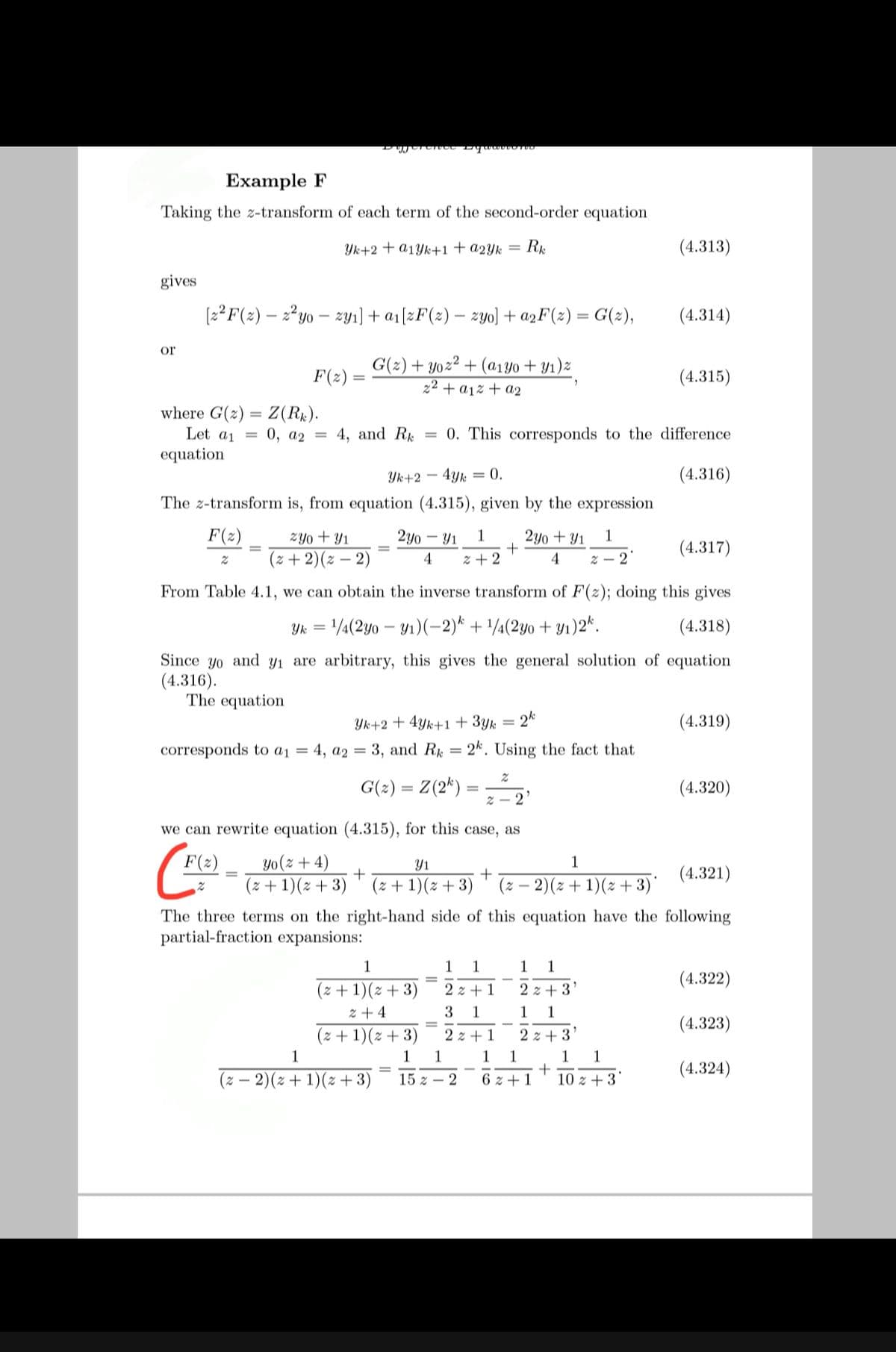we can rewrite equation (4.315), for this case, as F(2) yo(z +4) + Y1 1 (4.321) (z + 1)(2 + 3) + (z + 1)(z + 3) ' (z – 2)(z+ 1)(z+ 3)' The three terms on the right-hand side of this equation have the following partial-fraction expansions: 1 1 1 1 (4.322) (z + 1)(z + 3) z + 4 (z + 1)(z + 3) 2 z + 1 2 z + 3' 1 1 1 (4.323) 2 z + 1 2 z +3 1 1 1 1 1 1 1 (4.324) %3D (z – 2)(z+1)(z +3) 15 z - 2 6 z +1 10 z +3
we can rewrite equation (4.315), for this case, as F(2) yo(z +4) + Y1 1 (4.321) (z + 1)(2 + 3) + (z + 1)(z + 3) ' (z – 2)(z+ 1)(z+ 3)' The three terms on the right-hand side of this equation have the following partial-fraction expansions: 1 1 1 1 (4.322) (z + 1)(z + 3) z + 4 (z + 1)(z + 3) 2 z + 1 2 z + 3' 1 1 1 (4.323) 2 z + 1 2 z +3 1 1 1 1 1 1 1 (4.324) %3D (z – 2)(z+1)(z +3) 15 z - 2 6 z +1 10 z +3
Introductory Circuit Analysis (13th Edition)
13th Edition
ISBN:9780133923605
Author:Robert L. Boylestad
Publisher:Robert L. Boylestad
Chapter1: Introduction
Section: Chapter Questions
Problem 1P: Visit your local library (at school or home) and describe the extent to which it provides literature...
Related questions
Question
Explain the determine red

Transcribed Image Text:Example F
Taking the z-transform of each term of the second-order equation
Yk+2 + a1Yk+1+a2Yk = R¢
(4.313)
gives
(2?F(2) – 2²yo – zyı) + a1[zF(2) – zyo) + a2F(2) = G(z),
(4.314)
%3D
or
G(2) + yoz² + (a1Y0 + Y1)z
F(2)
(4.315)
z2 + a1% + a2
where G(2) = Z(Rx).
Let a1 =
0, a2 =
4, and R
= 0. This corresponds to the difference
equation
Yk+2 -
4Yk = 0.
(4.316)
The z-transform is, from equation (4.315), given by the expression
F(z)
zYo + Y1
2y0 – Y1
1
2y0 + Y1
1
+
(4.317)
(z + 2)(2 – 2)
4
z + 2
4
Z – 2
From Table 4.1, we can obtain the inverse transform of F(z); doing this gives
Yk = /¼(2y0 – Y1)(-2)* + '/¼(2yo + y1)2*.
(4.318)
Since yo and yı are arbitrary, this gives the general solution of equation
(4.316).
The equation
Yk+2 + 4yk+1 + 3yk
2k
(4.319)
corresponds to a1 = 4, a2 = 3, and R = 2k. Using the fact that
G(2) = Z(2*)
(4.320)
2 - 2
we can rewrite equation (4.315), for this case, as
F(2)
(- E+1)(: + 3) * (z + 1)(z + 3)
yo(z + 4)
Y1
1
(4.321)
(z – 2)(2 + 1)(z + 3)*
The three terms on the right-hand side of this equation have the following
partial-fraction expansions:
1
1
1
1
(4.322)
(z + 1)(z + 3)
z + 4
(z + 1)(z + 3)
2 z + 1
2 z + 3
3
1
1
1
(4.323)
2 z + 1
2 z + 3
1
1
1
1
1
1
1
(4.324)
(z – 2)(z + 1)(z + 3)
15 z – 2
6 z + 1
10 z + 3
Expert Solution
This question has been solved!
Explore an expertly crafted, step-by-step solution for a thorough understanding of key concepts.
Step by step
Solved in 4 steps with 4 images

Knowledge Booster
Learn more about
Need a deep-dive on the concept behind this application? Look no further. Learn more about this topic, electrical-engineering and related others by exploring similar questions and additional content below.Recommended textbooks for you

Introductory Circuit Analysis (13th Edition)
Electrical Engineering
ISBN:
9780133923605
Author:
Robert L. Boylestad
Publisher:
PEARSON

Delmar's Standard Textbook Of Electricity
Electrical Engineering
ISBN:
9781337900348
Author:
Stephen L. Herman
Publisher:
Cengage Learning

Programmable Logic Controllers
Electrical Engineering
ISBN:
9780073373843
Author:
Frank D. Petruzella
Publisher:
McGraw-Hill Education

Introductory Circuit Analysis (13th Edition)
Electrical Engineering
ISBN:
9780133923605
Author:
Robert L. Boylestad
Publisher:
PEARSON

Delmar's Standard Textbook Of Electricity
Electrical Engineering
ISBN:
9781337900348
Author:
Stephen L. Herman
Publisher:
Cengage Learning

Programmable Logic Controllers
Electrical Engineering
ISBN:
9780073373843
Author:
Frank D. Petruzella
Publisher:
McGraw-Hill Education

Fundamentals of Electric Circuits
Electrical Engineering
ISBN:
9780078028229
Author:
Charles K Alexander, Matthew Sadiku
Publisher:
McGraw-Hill Education

Electric Circuits. (11th Edition)
Electrical Engineering
ISBN:
9780134746968
Author:
James W. Nilsson, Susan Riedel
Publisher:
PEARSON

Engineering Electromagnetics
Electrical Engineering
ISBN:
9780078028151
Author:
Hayt, William H. (william Hart), Jr, BUCK, John A.
Publisher:
Mcgraw-hill Education,